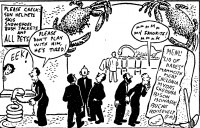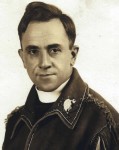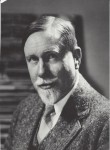Founded in 1904 by a group of explorers, naturalists and journalists including Adolphus Greely and Frank Chapman, The Explorers Club held annual black tie banquets in New York where members supped on exotic foods while speakers regaled them with tales of that year’s adventures. The 47th Explorers Club Annual Dinner (ECAD) held on January 13th, 1951, at the Hotel Roosevelt was a particularly epic event which featured a buffet of woolly mammoth, thawed from the Alaskan permafrost and served to the exploring elite alongside bison steaks, cheese straws and ice cream cake roll Buche Roosevelt.
 Here’s how one attendee, Herbert B. Nichols, described the evening’s fare in an article for the January 17th, 1951, issue of the Christian Science Monitor:
Here’s how one attendee, Herbert B. Nichols, described the evening’s fare in an article for the January 17th, 1951, issue of the Christian Science Monitor:
Chief attraction at the smorgasbord was a morsel of 250,000-year-old hairy mammoth meat such as Teddy Roosevelt feasted on in Alaska years ago. It originally was intended that this delicacy would be sought for in quantity as the main dish of the evening, but the dinner committee found the cost per plate would be $495.74 [about $4,500 in today’s dollars] (the price of raiding nature’s original “deep freeze” by hydraulic mining in the Valley of the Yukon on the chance of finding some).
This part of the menu was about to be canceled a few weeks ago when the Rev. Bernard Hubbard, better known as the “Glacier Priest,” told the committee about his own private stock at a place called Woolly Cove on Akutan Island. … Thanks to his generosity in “sharing the wealth,” we all had a taste of the rarest mammalian tit-bit on earth.
 The Glacier Priest was not the first explorer to claim to have a line on mammoth meat. A French explorer in 1872 said he and his team had subsisted entirely on “mammoth meat, broiled, roasted and baked” when they were in the frozen wilds of Russia. The team of scientists from St. Petersburg who excavated a mammoth frozen in the cliffs above the Beresovka River in 1901 were said to have supped on mammoth steaks. A later investigation by I.P. Tolmachoff found the edibility of the Beresovka mammoth was questionable. Apparently, “the flesh was so fresh and appealing that dogs devoured every piece thrown to them,” but when it came to human consumption, “although some of flesh recovered from the cadavers were ‘fibrous and marbled with fat’ and looked ‘as fresh as well-frozen beef or horsemeat,’ only dogs showed any appetite for it; ‘the stench…was unbearable’.” The taste was no better. One scientist had a nibble on some of the meat and promptly threw it up.
The Glacier Priest was not the first explorer to claim to have a line on mammoth meat. A French explorer in 1872 said he and his team had subsisted entirely on “mammoth meat, broiled, roasted and baked” when they were in the frozen wilds of Russia. The team of scientists from St. Petersburg who excavated a mammoth frozen in the cliffs above the Beresovka River in 1901 were said to have supped on mammoth steaks. A later investigation by I.P. Tolmachoff found the edibility of the Beresovka mammoth was questionable. Apparently, “the flesh was so fresh and appealing that dogs devoured every piece thrown to them,” but when it came to human consumption, “although some of flesh recovered from the cadavers were ‘fibrous and marbled with fat’ and looked ‘as fresh as well-frozen beef or horsemeat,’ only dogs showed any appetite for it; ‘the stench…was unbearable’.” The taste was no better. One scientist had a nibble on some of the meat and promptly threw it up.
There was a widespread notion that these mammoths discovered in the frozen parts of the world died and were instantly preserved in a block of pristine ice. In fact, they died, were eaten by scavengers, decayed and were eventually enveloped in the permafrost, which is not a fantasy glacier from a bottled water commercial but soil that has frozen solid. The Beresovka mammoth wound up in the cliffs because the carcass was caught in a landslide. Omaha Steaks it ain’t.
The 1951 Explorers Club Annual Dinner became quasi-legendary and inspired many future exotic food selections at subsequent banquets. While the focus today is less on extremely rare/extinct foods and more on sustainable but very much off-the-beaten-track options, the annual dinner still prominently features the weird and gross like fried tarantulas and goat-eyeball martinis. (I hope someone had the decency to raise one of the martinis and say “Here’s mud in your goat’s eye.”)
The question of what was actually eaten at the famous 1951 dinner is still an open one, however. Mammoth wasn’t officially on the menu, just “prehistoric meat.” It’s possible that the mammoth thing was a misunderstanding perpetuated by confused guests and press reports like Nichols’. To determine what really was eaten that night, a team of Yale University researchers turned to the one known sample taken from the dinner now in the mammal collection of the Yale Peabody Museum of Natural History.
 The source of the sample was Explorers Club member and Bruce Museum director Paul Griswold Howes who hadn’t been able to attend the dinner but asked for some leftovers to exhibit at his museum in Greenwich, Connecticut. The dinner’s organizer, Wendell Phillips Dodge, sent him a sample labeled Megatherium, an extinct South American giant ground sloth, not a mammoth. It remained at the Bruce Museum until 2001 when it was absorbed into the Peabody Museum collection.
The source of the sample was Explorers Club member and Bruce Museum director Paul Griswold Howes who hadn’t been able to attend the dinner but asked for some leftovers to exhibit at his museum in Greenwich, Connecticut. The dinner’s organizer, Wendell Phillips Dodge, sent him a sample labeled Megatherium, an extinct South American giant ground sloth, not a mammoth. It remained at the Bruce Museum until 2001 when it was absorbed into the Peabody Museum collection.
Yale anthropology professor and Peabody curator Eric Sargis enlisted graduate students Jessica R. Glass and Matt Davis to study the specimen. Glass, a PhD candidate in ecology and evolutionary biology, sought to extract and test DNA from the sample. Davis, a geology and geophysics student, focused on archival research. The Explorers Club helped fund the study via an Exploration Fund Grant and gave the team access to its records.
Adalgisa Caccone, a senior research scientist in the Department of Ecology and Evolutionary Biology and a co-author of the study, helped guide the DNA analysis at Yale’s Institute for Biospheric Studies, Center for Genetic Analyses of Biodiversity. “This was an interesting challenge, in part because the meat had been cooked,” Caccone said. “This was the first time I looked at the DNA of leftovers — very precious leftovers.”
Glass was able to extract DNA, purify it and conduct mitochondrial gene sequencing. The results matched the genetic profile for green sea turtle.
Meanwhile, Davis found an item in the Explorers Club archives that pointed in the same direction. It was a published statement from Dodge soon after the banquet, joking that he may have discovered a “potion” that turns green sea turtle into giant sloth meat.
It wasn’t just a point of curiosity about the famous dinner. Had the sample actually been Megatherium discovered in Alaska, it would have expanded the known range of the species by more than 600%. Instead it’s just a bit of ropy old leftover green sea turtle (Chelonia mydas) soup.
The study has been published in the journal PLOS ONE. It’s a pretty great read, especially the discussion section which delves into the confusion between mammoth and Megatherium and suggests the mammoth rumor was largely a mistake in the Nichols article that became enshrined in public memory despite its inaccuracy. The appendix about the bone marrow from a fossilized horse (Equus alaskensis) served at the 65th ECAD is not to be missed.
Wonderful, and very funny! One of the more entertaining uses of DNA-sequencing I’ve come across lately – and a nice nod to humor in scientific circles.
If I freeze meat or anything else, I consider it non-edible after one year. 250,000 year old meat would be disgusting, no matter how frozen it was.
It WAS disgusting, when one of our kittens, having found the dried-up and particularly DNA-untested remains of a small rodent or maybe feathered dinosaur, was playing around with it like mad.
Soon after, however, for the benefit of all except the rodents, living objects became much more tempting and smelly remains were soon frowned upon. According to my tests, 8 out of 10 behaved accordingly.
Nobody’s left this here yet?
http://theinfosphere.org/images/a/af/Mammalmulcher.png
Sometime late in the 1950s, a story circulated at my school that the scion of one of the richest families had attended, with his father, a special meeting of some sort at which meat from recently found Wooly mammoth was served. It may have been the Explorer’s Club or something like it- the father was known for big game hunting and the family often went on safaris and other exotic vacations. There was considerable skepticism about whether our classmate had actually eaten mammoth meat, but some were inclined to believe it because of newspaper stories of the finds, and the status of the family. Personally, I was (and am) doubtful, based on the boy’s known propensity to make up stories I knew to be untrue. He claimed that the meat was like fresh steak. My family had a huge freezer. Nothing like freezer burned meat.
Rich people are weird